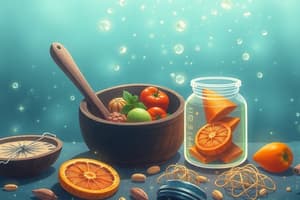Podcast
Questions and Answers
What is the major difference between a double-drum drier and a single-drum drier in terms of structure?
What is the major difference between a double-drum drier and a single-drum drier in terms of structure?
Double-drum drier consists of two drums situated close together and rotating towards each other.
Which type of material is suitable for a vacuum-drum dryer?
Which type of material is suitable for a vacuum-drum dryer?
- Low viscosity liquids
- Heat-insensitive materials
- High viscosity liquids
- Heat-sensitive materials (correct)
The vacuum-drum dryer equipment is enclosed within a vacuum tight chamber to reduce pressure, allowing the use of __________ temperatures.
The vacuum-drum dryer equipment is enclosed within a vacuum tight chamber to reduce pressure, allowing the use of __________ temperatures.
low
What is the principle behind food preservation by dehydration?
What is the principle behind food preservation by dehydration?
Which range of water activity (aw) is typical for low moisture foods (LMF)?
Which range of water activity (aw) is typical for low moisture foods (LMF)?
Temperature control in drying should be at an optimum level to evaporate _______ from food.
Temperature control in drying should be at an optimum level to evaporate _______ from food.
Fungistatic substances like sorbic acid are used to preserve intermediate moisture foods (IMF).
Fungistatic substances like sorbic acid are used to preserve intermediate moisture foods (IMF).
Match the drying equipment with suitable factors affecting their selection:
Match the drying equipment with suitable factors affecting their selection:
What is the purpose of the knife located ½ to ¾ of a revolution from the point of feed application in the double drum dryer?
What is the purpose of the knife located ½ to ¾ of a revolution from the point of feed application in the double drum dryer?
What distinguishes the double-drum dryer from the single-drum dryer?
What distinguishes the double-drum dryer from the single-drum dryer?
The vacuum-drum dryer is suitable for materials that are not heat-sensitive.
The vacuum-drum dryer is suitable for materials that are not heat-sensitive.
In what type of conditions can the vacuum drum dryer be operated?
In what type of conditions can the vacuum drum dryer be operated?
What is the main principle of food preservation by dehydration?
What is the main principle of food preservation by dehydration?
List two advantages of dehydrated foods.
List two advantages of dehydrated foods.
Dehydrated foods typically maintain all of their original nutritional value.
Dehydrated foods typically maintain all of their original nutritional value.
The objectives of drying are to reduce the water content in the product to less than __% or achieve a water activity (aw) between 0.00 to 0.60.
The objectives of drying are to reduce the water content in the product to less than __% or achieve a water activity (aw) between 0.00 to 0.60.
Match the following factors with their effects on the drying rate:
Match the following factors with their effects on the drying rate:
Flashcards are hidden until you start studying
Study Notes
Chapter 5: Preservation by Dehydration
High Moisture Foods (HMF)
- Water activity (aw) range: 0.99 to 0.90
- Examples: fresh milk, meat, fish, vegetables, fruits
- Easily spoiled by bacteria or fast-growing moulds unless refrigerated or heated (canned)
Intermediate Moisture Foods (IMF)
- Water activity (aw) range: 0.90 to 0.60
- Examples: Aged cheese, hard salami, heavily salted fish, jams, marshmallows, and dried fruits
- Preserved by adding salt and/or sugar and intense drying process
- Spoilage caused by zero-tolerant moulds or osmo-tolerant yeasts, and halo-tolerant bacteria (less frequent)
- Fungistatic substances like sorbic acid, sulphur dioxide, or smoke are used to preserve IMF products
Low Moisture Foods (LMF)
- Water activity (aw) range: 0.60 to 0.20
- Examples: Chocolate, confectioneries, honey, dried eggs, cocoa, cake mixes, powdered milk, dried cereals, and vegetables
- Dried to suitable (low) aw value, making it unsuitable for microbial growth
Dehydration Principle
- All living organisms need water to survive
- Drying of foods reduces moisture content and water activity, stopping spoilage microbes, enzymes, and undesirable biochemical reactions
- Objectives of drying:
- Reduce water content in the product (water content < 25% or aw between 0.00 to 0.60)
- Extend shelf life
- Reduce enzyme activity and undesirable chemical reactions
Advantages of Dehydrated Foods
- Smaller and lighter end products, reducing handling, storage, and transport costs
- Maintain much of the original nutritional value
- Long shelf life, requiring no preservatives
Changes Due to Dehydration
- Size and shape changes due to shrinkage
- Colour changes due to removal of water, exposure to high temperature, and air
- Texture changes due to shrinkage
- Flavour changes due to loss of volatile flavor compounds and development of an undesirable cooked flavor
- Nutritional quality changes due to loss of water-soluble nutrients
Factors Affecting Drying Rate
- Speed of drying: need to be conducted rapidly but not too fast to avoid case hardening
- Temperature: need to control temperature at an optimum level to evaporate moisture
- Humidity and ventilation: need to have low humidity in air and adequate ventilation in the dryer
- Uniformity: need to dry food evenly by spreading thin layers, flipping pieces frequently, and shifting racks in the dryer
Dehydration Methods and Drying Equipment
- Fluidized bed dryer
- Sun drying (solar)
- Cabinet drying (hot air)
- Microwave drying
- Freeze drying
- Spray drying
- Drum drying
- Single-drum dryer
- Double-drum dryer
- Vacuum-drum dryer
Chapter 5: Preservation by Dehydration
Moisture in Food
- High Moisture Foods (HMF):
- Range of aw = 0.99 to 0.90
- Examples: fresh milk, meat, fish, vegetables, fruits
- Easily spoiled by bacteria or fast-growing moulds unless refrigerated or heated (canned)
- Intermediate Moisture Foods (IMF):
- Range of aw = 0.90 to 0.60
- Examples: Aged cheese, hard salami, heavily salted fish, jams, marshmallows, and dried fruits
- Preserved by adding salt and/or sugar and intense drying process
- Spoilage caused by zero-tolerant moulds or osmo-tolerant yeasts, and halo-tolerant bacteria
- Fungistatic substances like sorbic acid, sulphur dioxide, or smoke used to preserve IMF products
- Low Moisture Foods (LMF):
- Range of aw = 0.60 to 0.20
- Examples: Chocolate, confectioneries, honey, dried eggs, cocoa, cake mixes, powdered milk, dried cereals, and vegetables
- Dried to a suitable (low) aw value, unsuitable for microbial growth
Dehydration Principle
- Living organisms need water to survive
- Drying of foods reduces moisture content and water activity (aw), stopping microbial growth, enzyme activity, and undesirable biochemical reactions
- Objectives of drying:
- Reduce water content in the product (<25% or aw between 0.00 to 0.60)
- Extend shelf life
- Reduce enzyme activity and undesirable chemical reactions
Advantages of Dehydrated Foods
- Smaller and lighter end products, reducing handling, storage, and transport costs
- Maintain much of the original nutritional value
- Long shelf-life with no preservatives required
Changes Due to Dehydration
- Size and shape changes due to shrinkage
- Colour changes due to removal of water, exposure to high temperature, and air
- Texture changes due to shrinkage
- Flavour changes due to loss of volatile flavor compounds and development of an undesirable cooked flavor
- Nutritional quality changes due to loss of water-soluble nutrients
Factors Affecting the Drying Rate
- Speed of drying: need to be conducted rapidly, but not too fast to prevent case hardening
- Temperature: need to control at an optimum level to evaporate moisture
- Humidity and Ventilation: need low humidity and adequate ventilation to prevent moisture accumulation
- Uniformity: need to dry food evenly by spreading thin layers, flipping pieces frequently, and shifting racks in the dryer
Dehydration Methods and Drying Equipment
- Fluidized Bed Dryer
- Sun Drying (Solar)
- Cabinet Drying (Hot Air Drying)
- Microwave Drying
- Freeze Drying
- Spray Drying
- Drum Drying
Specific Drying Methods
- Sun Drying:
- Oldest method of food preservation
- Advantages: renewable energy source, simple, and uncomplicated
- Disadvantages: only practical in hot, dry climates, requires long time, hard to control weather, pollution, and animals
- Indirect Solar Dryer:
- Collects sun's rays using heat exchanger (solar collectors)
- Even drying using hot air flows through or over the product
- Cabinet Drying:
- Suitable for solid food materials
- Advantages: efficient, simple, and suitable for industrial application
- Microwave Drying:
- Uses high-frequency electromagnetic waves of radiant energy
- Advantages: penetrating heat leads to uniform drying, selective absorption by liquid water
- Disadvantages: complicated equipment, expensive
- Freeze Drying:
- Food is frozen, then placed in a vacuum chamber under reduced pressure
- Ice changes directly to water vapour (sublimation) and is carried away by circulating heated air
- Advantages: low thermal damage, maintains nutritional values and vitamins, no cooked flavour
- Disadvantages: high capital and operation costs, initial freezing can damage certain products
- Spray Drying:
- Suitable for foods in the form of liquids or slurries
- Advantages: rapid drying, uniform particle size
- Used to produce non-fat dried milk and instant coffee
- Drum Drying:
- Continuous contact dryer for drying products initially in slurries
- Suitable for heat-sensitive products, used to produce potatoes, corn syrup, and baby foods
Studying That Suits You
Use AI to generate personalized quizzes and flashcards to suit your learning preferences.




